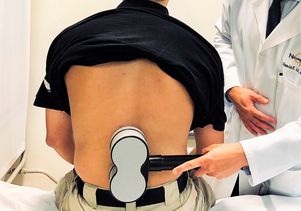
In UCLA study, magnetic stimulation of lower spine eliminates need for catheter for up to 4 weeks

UCLA neuroscientists, led by Dr. Daniel Lu, stimulated the lower spinal cord through the skin with a magnetic device placed at the lumbar spine.
More than 80 percent of the 250,000 Americans living with a spinal cord injury lose the ability to urinate voluntarily after their injury. According to a 2012 study, the desire to regain bladder control outranks even their wish to walk again.
In a study of five men whose injuries occurred five to 13 years ago, UCLA neuroscientists stimulated the lower spinal cord through the skin with a magnetic device placed at the lumbar spine. The research is the first to show that the technique enables people with spinal cord injuries to recover significant bladder control for up to four weeks between treatments. The findings are published today in Scientific Reports.
The treatment improved the men’s quality of life by an average of 60 percent (according to a questionnaire they completed before and after the study). And if the technique is replicable on other people, it could help reduce the social stigma and health risks linked to frequent catheter use.
“We were excited to see a positive effect in all five patients after only four sessions of mild magnetic stimulation,” said Dr. Daniel Lu, the study’s principal investigator and an associate professor of neurosurgery at the David Geffen School of Medicine at UCLA. “The benefit persisted from two to four weeks, suggesting that the spinal cord’s neural circuitry retains a ‘memory’ of the treatment.”
People with spinal cord injuries must slide a narrow tube called a catheter into the bladder several times a day to drain urine. Patients whose injuries prevent use of their hands must depend on a caretaker to insert the catheter.
But long-term reliance on a catheter can be dangerous, because the procedure can introduce bacteria that lead to urinary tract infections and permanent scarring. Bladder problems after spinal cord injuries can also lead to kidney failure and death. Lu hopes his laboratory’s research will ultimately reduce those risks by eliminating the need for catheters.

Dr. Daniel Lu
Lu and his colleagues applied magnetic stimulation to the spinal cord to access the cellular machinery controlling urination. Doctors previously have used the same approach with the brain to improve nerve cell function for conditions ranging from depression to migraine.
